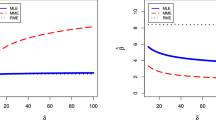Abstract
The logical purpose for a statistical tolerance limit is to predict future outcomes for some (say, production) process. The coverage value γ is the percentage of the future process outcomes to be captured by the prediction, and the confidence level (1 – α) is the proportion of the time we hope to capture that percentage γ. Tolerance limits of the type mentioned above are considered in this paper, which presents a new technique for constructing exact statistical (lower and upper) tolerance limits on outcomes (for example, on order statistics) in future samples. Attention is restricted to the two-parameter Weibull distribution under parametric uncertainty. The technique used here emphasizes pivotal quantities relevant for obtaining tolerance factors and is applicable whenever the statistical problem is invariant under a group of transformations that acts transitively on the parameter space. It does not require the construction of any tables and is applicable whether the experimental data are complete or Type II censored. The exact tolerance limits on order statistics associated with sampling from underlying distributions can be found easily and quickly making tables, simulation, Monte Carlo estimated percentiles, special computer programs, and approximation unnecessary. The proposed technique is based on a probability transformation and pivotal quantity averaging. It is conceptually simple and easy to use. The discussion is restricted to one-sided tolerance limits. Finally, we give numerical examples, where the proposed analytical methodology is illustrated in terms of the two-parameter Weibull distribution. Applications to other log-location-scale distributions could follow directly.
Similar content being viewed by others
REFERENCES
Patel, J.K., Tolerance limits: A review, Communications in Statistics: Theory and Methodology, 1986, vol. 15, pp. 2719–2762.
Dunsmore, J.R., Some approximations for tolerance factors for the two parameter exponential distribution, Technometrics, 1978, vol. 20, pp. 317–318.
Guenther, W.C., Patil, S.A., and Uppuluri, V.R.R., One-sided β-content tolerance factors for the two parameter exponential distribution, Technometrics, 1976, vol. 18, pp. 333–340.
Engelhardt, M. and Bain, L.J., Tolerance limits and confidence limits on reliability for the two-parameter exponential distribution, Technometrics, 1978, vol. 20, pp. 37–39.
Guenther, W.C., Tolerance intervals for univariate distributions, Naval Res. Logist. Q., 1972, vol. 19, pp. 309–333.
Hahn, G.J. and Meeker, W.Q., Statistical Intervals: A Guide for Practitioners, New York: John Wiley & Sons, 1991.
Nechval, K.N. and Nechval, N.A., Constructing lower simultaneous prediction limits on observations in future samples from the past data, Comput. Ind. Eng., 1999, vol. 37, pp. 133–136.
Nechval, N.A. and Vasermanis, E.K., Improved Decisions in Statistics, Riga: Izglitibas soli, 2004.
Nechval, N.A. and Nechval, K.N., A new approach to constructing simultaneous prediction limits on future outcomes under parametric uncertainty of underlying models, in IAENG Transactions on Engineering Sciences, Ao Sio-Long, Chan Alan Hoi-Shou, Katagiri Hideki, and Xu Li, Eds., London: Taylor & Francis Group, 2014, pp. 1–13.
Nechval, N.A. and Nechval, K.N., Tolerance limits on order statistics in future samples coming from the two-parameter exponential distribution, Am. J. Theor. Appl. Stat., 2016, vol. 5, pp. 1–6.
Nechval, N.A., Nechval, K.N., Prisyazhnyuk, S.P., and Strelchonok, V.F., Tolerance limits on order statistics in future samples coming from the Pareto distribution, Autom. Control Comput. Sci., 2016, vol. 50, pp. 423–431.
Nechval, N.A., Nechval, K.N., and Strelchonok, V.F., A new approach to constructing tolerance limits on order statistics in future samples coming from a normal distribution, Adv. Image Video Process., 2016, vol. 4, pp. 47–61.
Nechval, N.A., Berzins, G., Balina, S., Steinbuka, I., and Nechval, K.N., Constructing unbiased prediction limits on future outcomes under parametric uncertainty of underlying models via pivotal quantity averaging approach, Autom. Control Comput. Sci., 2017, vol. 51, pp. 331–346.
Nechval, N.A., Nechval, K.N., and Berzins, G., A new technique for constructing exact tolerance limits on future outcomes under parametric uncertainty, in Advanced Mathematical Techniques in Engineering Sciences, Ram, M. and Davim, J.P., Eds., London: Taylor & Francis Group, 2018, pp. 203–226.
Lawless, J.F., On the estimation of safe life when the underlying life distribution is Weibull, Technometrics, 1973, vol. 15, pp. 857–865.
Mee, R.W. and Kushary, D., Prediction limits for the Weibull distribution utilizing simulation, Comput. Stat. Data Anal., 1994, vol. 17, pp. 327–336.
Fertig, K.W., Meyer, M.E., and Mann, N.R., On constructing prediction intervals from a Weibull or extreme-value distribution, Technometrics, 1980, vol. 22, pp. 567–573.
Engelhardt, M. and Bain, L.J., On prediction limits for samples from a Weibull or extreme-value distribution, Technometrics, 1982, vol. 24, pp. 147–150.
Lieblein, J. and Zelen, M., Statistical investigation of the fatigue life of deep-groove ball bearing, J. Res. Natl. Bur. Stand., 1956, vol. 47, pp. 273–316.
Mann, N.R. and Saunders, S.C., On evaluation of warranty assurance when life has a Weibull distribution, Biometrika, 1969, vol. 56, pp. 615–625.
ACKNOWLEDGMENTS
The authors would like to thank the anonymous reviewers for their valuable comments that helped to improve the presentation of this paper.
Author information
Authors and Affiliations
Corresponding author
Additional information
The article is published in the original.
About this article
Cite this article
Nechval, N.A., Nechval, K.N. & Berzins, G. A New Technique for Intelligent Constructing Exact γ-content Tolerance Limits with Expected (1 – α)-confidence on Future Outcomes in the Weibull Case Using Complete or Type II Censored Data. Aut. Control Comp. Sci. 52, 476–488 (2018). https://doi.org/10.3103/S0146411618060081
Received:
Revised:
Accepted:
Published:
Issue Date:
DOI: https://doi.org/10.3103/S0146411618060081




